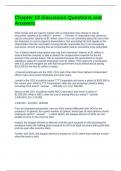Chapter 12 discussion Questions and
Answers
What nontax and tax reasons explain why a corporation may choose to cap its
executives' salaries at $1 million? - answer • Nontax: A corporation may choose to
cap its executives' salaries at $1 million, even if it is not concerned about the loss of the
tax deduction, to send a signal to shareholders. Not exceeding the limit signals to the
shareholders that the corporation is being fiscally responsible by (1) not overpaying
executives, and (2) ensuring that all compensation paid to executives is tax deductible.
Tax: Publicly-traded corporations may cap their executives' salaries at $1 million to
ensure that the company is able to deduct the compensation expense for the full
amount of the compensation. This is important because the government no longer
subsidizes salary for covered employees over $1 million. This means for a corporation
with a 21 percent marginal tax rate that the government would effectively be paying
$210,000 for the first $1 million in salary.
• Covered employees are the CEO, CFO, and of the other three highest compensated
officers (plus all covered employees from prior years.
Lynette is the CEO of publicly traded TTT Corporation and earns a salary of $200,000 in
the current year. What is TTT Corporation's after-tax cost of paying Lynette's salary
excluding FICA taxes? - answer 200,000 x (1-.21)= 158,000
Marcus is the CEO of publicly traded ABC Corporation and earns a salary of
$1,500,000. What is ABC's after-tax cost of paying Marcus's salary? - answer
1,000,000 (.21)= 210,000
1,500,000 - 210,000= 1290000
From an employee perspective, how are ISOs treated differently than NOs for tax
purposes? In general, for a given number of options, which type of stock options should
employees prefer? - answer • Unlike NQOs, the bargain element of ISOs are not
taxable income on the exercise date.
Instead, the bargain element is deferred until the stock acquired is sold assuming the
employee meets the holding period required for ISOs (at least two years after grant date
and one year after exercise date).
Further, with ISOs, the bargain element is treated as LTCG rather than ordinary income
when the stock is sold.
, For these reasons, employees generally prefer ISOs over an equivalent number of
NQOs
From an employer perspective, how are ISOs treated differently than NOs for tax
purposes? In general, for a given number of options, which type of stock options should
employers prefer? - answer • In contrast to NQOs, employers never receive a
deduction for ISOs.
Thus, employers generally prefer to issue NQOs over an equivalent number of incentive
stock options.
Why do employers use stock options in addition to salary to compensate their
employees? For employers, are stock options treated more favorably than salary for tax
purposes? Explain. - answer • Because stock options reward employees for making
choices that increase the share price of the corporations where they are employed, this
form of compensation is considered to be superior to salary in terms of motivating
employees to behave more like owners in short, stock options align the incentives of
employees and owners.
In addition, employers may use stock options to compensate their employees without a
cash outlay.
For tax purposes, NQOs are treated the same as salary and wages. The employer
receives a deduction equal to the bargain element (FMV of shares on exercise date less
the strike price).
• NOs may allow employers to deduct executive compensation above $1 million, and
NQOs can generate tax deductions without a cash outlay.
Cammie received 100 NQ0s (each option provides a right to purchase 10 shares of
MNL stock for $10 per share). She started working for MNL Corporation four years ago
(5/1/Y1) when MNL's stock price was $8 per share. Now (8/15/Y5) that MNL's stock
price is $40 per share, she intends to exercise all of her options.
After acquiring the 1,000 ML shares with her stock options, she held the shares for over
one year and sold (on 10/1/6) them at $60 per share.
a. What are Cammie's taxes due on the grant date (5/1/Y1), exercise date (8/15/Y5),
and sale date (10/1/Y6), assuming her ordinary marginal rate is 32% and her long-term
capital gains rate is 15%? - answer - Grant date: 0
• Exercise date: 1000 (40-10) x .32= 9600
• Sale date: 1000 (60-40) x .15= 3000
Cammie received 100 NQ0s (each option provides a right to purchase 10 shares of
MNL stock for $10 per share). She started working for MNL Corporation four years ago
(5/1/Y1) when MNL's stock price was $8 per share. Now (8/15/Y5) that MNL's stock
price is $40 per share, she intends to exercise all of her options.




